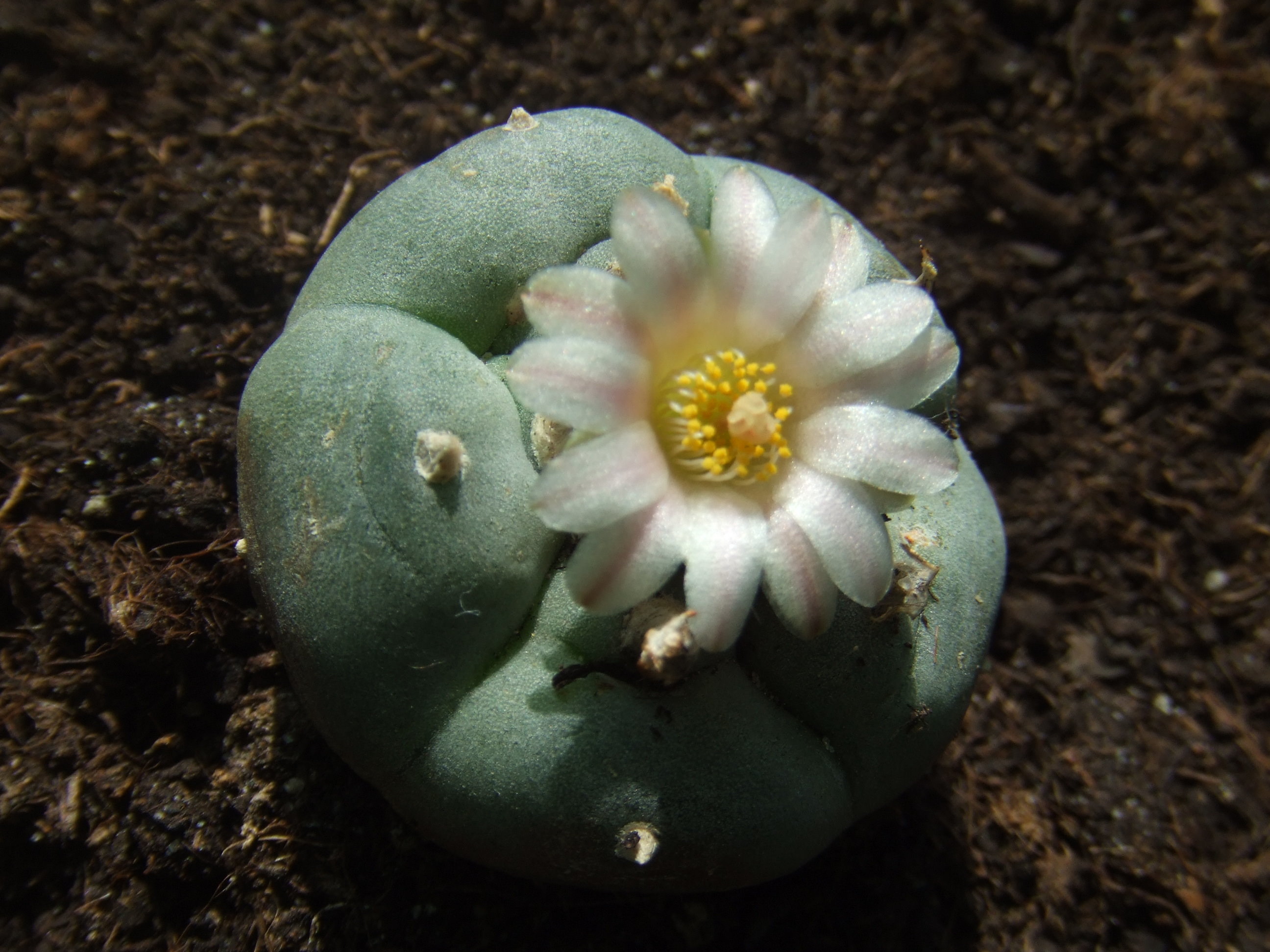- Lophophora
Taxobox
name = "Lophophora"

image_width = 250px
image_caption = "Lophophora williamsii" cluster
regnum =Plant ae
divisio = Magnoliophyta
classis = Magnoliopsida
ordo =Caryophyllales
familia = Cactaceae
subfamilia =Cactoideae
tribus =Cacteae
genus = "Lophophora"
genus_authority =J.M.Coult.
subdivision_ranks =Species
subdivision = "Lophophora diffusa " "Lophophora williamsii " -Peyote "Lophophora" (
John M. Coulter ,1894 ) is agenus of spineless, button-like cacti native to the southwesternUnited States (Texas andNew Mexico ) through NortheastMexico and South toQuerétaro .The species are extremely slow growing, sometimes taking up to thirty years to reach flowering age (at the size of about a golf ball, not including the root) in the wild. Cultivated specimens grow considerably faster, usually taking between three to ten years to reach from seedling to mature flowering adult. Due to this slow growth and over-harvesting by collectors, the species are considered to be in danger of extinction in the wild.
Species
"Lophophora" has been reported to be comprised of everything from one species, "L. williamsii" with varieties, to the four species "L. diffusa", "L. fricii", "L. viridescens", and "L. williamsii". Most modern authorities consider "Lophophora" to be a genus of two species, "L. diffusa" and "L. williamsii". Recent
DNA sequencing studies (Butterworth et al. 2002) have shown that "L. diffusa" and "L. williamsii" indeed are distinct species. DNA evidence from the alleged species "L. fricii" and "L. viridescens" would allow for more accurate classification.Below is given a key for the currently accepted species along with the "species" and varieties that must be considered synonymous. Detailed arguments for this classification can be found in "" (Anderson 1996, pp. 210-219).
= "Lophophora diffusa" (Croizat) Bravo 1967=The plants are yellow-green, usually lacking well-defined ribs and furrows. The podaria are rarely elevated, but are broad and flat. The tufts of hair are usually spread unequally on the prominent podaria. The flowers are commonly whitish to yellowish-white. "L. diffusa" occurs at the south end of the range of the genus in Querétaro state, Mexico.
"L. diffusa" contains zero to trace amounts of
mescaline ;pellotine is the principalalkaloid .Several people have reported that this cactus is psychoactive if ingested, though the experience is not similar to peyote. This species looks almost identical to peyote, though it is legal to possess.Fact|date=February 2007
Synonyms
*"Lophophora echinata" var. "diffusa" Croizat 1944
*"Lophophora williamsii" var. " diffusa" (Croizat) Rowley 1979
*"Lophophora diffusa" var. "koehresii" Riha 1996, "L. williamsii" var. "koehresii" (Riha) Grym 1997
*"Lophophora diffusa" subsp. "viridescens" Halda 1997, "L. viridescens" (Halda) Halda 1997"Lophophora williamsii" (Lemaire ex Salm-Dyck) J. M. Coulter
The plants are blue-green, usually with well-defined
ribs and furrows. The tufts of hair are usually equally spaced on the ribs. The flowers are pinkish or rarely whitish. "L. williamsii" occurs in the full range of the genus except in Querétaro state, Mexico.The
mescaline content in dried Lophophora williamsii "Peyote" can reach almost 7%.Genus Lophophora ~ Species-
Lophophora decepiens
Lophophora diffusa
Lophophora fricii
Lophophora koehresii
Lophophora jourdaniana
Lophophora williamsii
Many, many more strains and cultivator exist, espeically of Lophophora williamsii.
~Diffusae~
Lophophora diffusa
Lophophora koehresii
~Williamsiae~
Lophophora decepiens
Lophophora fricii (Possibly Diffusae)
Lophophora jourdaniana (Possibly a Hybrid)
Lophophora williamsii
Out-of-date-names-
Anhalonium lewiniiEchinocactus williamsii Lophophora echinataLophophora lewinii Lophophora luteaLophophora viridescensLophophora ziegleri
Synonyms
*"Echinocactus williamsii" Lemaire ex Salm-Dyck 1845
*"Lophophora lewinii" (K. Schumann) Rusby 1894
*"Lophophora echinata" Croizat 1944
*"Lophophora fricii" Habermann 1974, "L. williamsii" var. "fricii" (Habermann) Grym 1997, "L. diffusa" subsp. "fricii" (Habermann) Halda 1997
*"Lophophora jourdaniana" Habermann 1975One curious and under-reported observation is that these cacti have thigmotactic
anthers . This means that as its anthers are touched they curl over, depositing their pollen. This movement can be seen by gently poking the anthers of an open Lophophora flower. Thus one of the slowest growing plants in the world makes one of the fastest plant movements!Ethnobotany, Ethnomedical, and Entheogen Use
*"
Lophophora williamsii ", commonly known aspeyote , is noted for its psychotropic alkaloids; seepeyote for further details.*These alkaloids are absent or only found in extremely small amounts in the other species "
Lophophora diffusa ". While "L. diffusa" is known for havingpsychoactive effects, these effects are described not so much as "visionary", likepeyote , but rather a delirioushigh such as those associated with the use of "Datura " and "Belladonna ".*The stem is used as a spiritual hallucinogen, and is applied
topically as agalactogogue , orlactation aid Fact|date=February 2007.Etymology
"Lophophora" means "crest-bearing", referring to the tufts of
trichome s that adorn eachtubercle . The name is derived from the two Greek words "λοφος" ("lophos", the crest of a hill or helmet) and "φορεω" ("phoreo", to carry).References
*
Edward F. Anderson , "The Cactus Family " (Timber Press , 2001) ISBN 0-88192-498-9, pp. 396-397*
Edward F. Anderson , "" (University of Arizona Press ; 2nd edition, 1996) ISBN 0-8165-1654-5*
Lyman Benson , "Cacti of the United States and Canada " (Stanford University Press , 1983) ISBN 0-8047-0863-0, pp. 680-683* C. A. Butterworth & J. H. Cota-Sanchez, & R. S. Wallace (2002), ”Molecular systematics of Tribe Cacteae (Cactaceae: Cactoideae): A phylogeny based on rpl16 intron sequence variation”, "Systematic Botany" "27" (2), 257-270.
*
John M. Coulter , " [http://www.gutenberg.org/dirs/etext98/nasoc10.txt Preliminary revision of the North American species of Cactus, Anhalonium, and Lophophora] " (Contributions from the U. S. National Herbarium 3(2), 1894)*
Rudolf Grym , "Rod/Die Gattung Lophophora " (Vydavateľstvo Igor Dráb, 1997) ISBN 80-85441-11-XExternal links
* [http://www.lophophora.info/e_auswahl2.htm Habitat photos of Lophophora]
* [http://lophophora.blogspot.com/ Notes on growing Lophophora]
* [http://mynka.fotosik.pl/albumy/13643.html Cultivars photos of Lophophora]
* [http://au.youtube.com/watch?v=_EfmaGY8cCU lophophora collection video]
Wikimedia Foundation. 2010.
